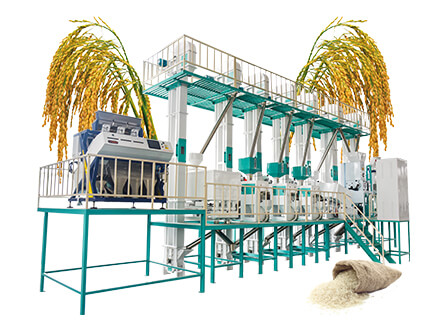Rice is the most important staple food crop in India. It provides food for 65% of the population in India. The crop occupies about 37 % of the total cropped area and 44% (2001-02 position ) of the total production of food grains in India. West Bengal is the leading producer of paddy in the country. It accounts for 16.39% of the total production, and the other leading states are Uttar Pradesh (13.38%), Andhra Pradesh (12.24%), Punjab (9.47%), Orissa (7.68%) and Tamil Nadu (7.38%); the remaining states account for 33.45% of the production. Paddy in its raw form cannot be consumed by human beings. It needs to be suitably processed for obtaining rice. The Rice milling is the process that helps in removal of hulls and bran’s from paddy grains to produce polished rice. If you live in a highly paddy producing area, you can establish a rice mill plant of your own.
The improved rice mills have a better husk and rice bran aspiration system. The same prevents mixing of finely broken with rice bran. Therefore, the quality of rice bran obtained is better. Rice mill plant is the techno-commercially profitable business.
RICE MILL PLANT MARKET POTENTIAL
Rice Mill Plant Rice is an essential food for the population of India. India is a large market with a widening middle-income group and an increasing number of double-income households. It holds great potential for the packaged rice segment. The bye-product of such Mills, Rice bran, could find great demand as raw material among solvent Extraction Plants.
India leads globally in the production and export of Basmati rice. The country has exported 37,02,260.12 MT of Basmati Rice to the world for the worth of Rs. 27,597.87 crores during the year 2014-15. Major export destinations are Saudi Arabia, Iran, United Arab Emirates, Iraq and Kuwait. Rice mill plant is the largest agro-processing industry of the country. Establishing rice mill plant is a profitable business in India.
RICE MILL PLANT BUSINESS REGISTRATION
In starting the business, you will need to obtain several different license from Govt. authority.
1. Register your business with ROC.
2. Udyog Aadhaar MSME Registration
3. Obtain Factory License.
4. Apply for ‘consent to establish’ and ‘consent to operate’ from Pollution Control Board
5. Apply for a license according to the Rice-Milling Industry (Regulation) Act, 1958.
6. Obtain VAT registration
7. You must comply with PFA and ESIC registration for the employees.
8. For export, IEC registration is mandatory.
RICE MILL PLANT MACHINERY
Required Machines are:
1. Raw paddy cleaner cum aspirator consisting of large aspiration of desired suction width. It must be fitted with double fans with necessary damper controls.
2. One rubber roll paddy sheller
3. Paddy Separator to separate unshelled paddy from deshelled paddy.
4. Blowers, husk and barn aspirators for aspiration of light particles. It also separates husks from dehusked kernels and bran from milled rice.
5. Cone type paddy polishers
6. Rice grader/ aspirator for purification and grading of polished rice grains
7. Bucket elevators for bulk transport and conveyance
RICE MILL PLANT UNIT ESTABLISHMENT
First, you must figure out the requirement of the area. It broadly depends on two aspects. Whether the unit will be using a parboiling unit for pre-treatment of paddy before the commencement of milling operation or it will be directly milling raw paddy. Generally, 1.00 to 1.50 acre of land is required for establishing an improved rice milling unit having an installed processing capacity of 2 MT/ hr.
The total power requirement will to the tune of 75 KW. The essential power requirement of the unit is about 90 HP and accordingly suitable standby generator provision is made. Water is required for parboiling and domestic consumption purpose. You must ensure suitable arrangements for continuous water supply of desired quality and quantity.
You must build several constructions for different unit activity. Such as raw paddy godown, cleaning unit, drier and necessary supporting structures such as boiler/blower system etc., milling section, finished product stores, machine rooms etc. You must maintain Quality Control and Standards as per AGMARK specification.
RICE MILL PLANT MANUFACTURING PROCESS
Rice milling unit operation includes several steps. Those are:
Step 1
Pre-Cleaning: Removing all impurities and unfilled grains from paddy
Step 2
De-stoning: Separating small stones from paddy
Step 3
Parboiling: It helps to improve the nutritional quality by gelatinization of starch inside the rice grain. It improves the milling recovery percent during dehulling and polishing / whitening operation
Step 4
Husking: Removing husk from paddy
Step 5
Husk Aspiration: Separating the husk from brown rice/ unhusked paddy
Step 6
Paddy Separation: Separating the unhusked paddy from brown rice
Step 7
Whitening: Removing all or part of the bran layer and germ of brown rice
Step 8
Polishing: Improving the appearance of milled rice by removing the remaining bran particles and by polishing the exterior of the milled kernel
Step 9
Length Grading: Separating small and large broken from head rice
Step 10
Blending: Mixing head rice with predetermined amount of broken, as required by the customer
Step 11
Weighing and bagging: This is the last step in rice mill plant operation. Preparing the milled rice for transport to the customer


